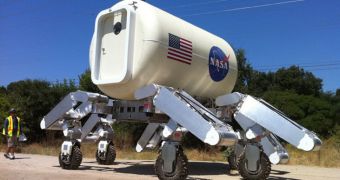As part of the American space agency's attempt to return to the Moon, engineers and other experts are working on a rover that could eliminate the need for astronauts to wear pressure suits. The All-Terrain, Hex-Limbed, Extra-Terrestrial Explorer (ATHLETE) platform could carry a pressurized module, in which astronauts could roam freely, without the need to carry cumbersome suits that hinder their movements. Recently, the robot underwent important tests at the NASA Jet Propulsion Laboratory (JPL), in Pasadena, California, which certified the important milestone the mission reached.
In addition to the JPL, the Johnson Space Center and the Ames Research Center, in collaboration with the Stanford University and the Boeing Corporation, are also involved in designing and building the platform. Testing the versatile platform requires a large stretch of unpaved land, which is not available at the JPL grounds. As such, experts here decided to test the machine in a wash adjacent to the lab grounds, which allows them to store ATHLETE in its hangar between tests. The Arroyo Seco region holds sufficient dirt roads allow for relevant tests, JPL team members say.
By the end of this project, NASA will be able to confidently conduct an affordable lunar-surface flight experiment that demonstrates this technology on the Moon and subsequently uses it as part of the Human Lunar Return campaign to perform the needed robotic/human vehicle functions on the lunar surface. The current machine undergoing testing is only a ½ scale model of the real deal, experts say. They add that the assessments they conducted thus far are only the start of an official round of tests, which is due to begin next month.
The goal of the investigation was to determine whether the robot could travel at least 25 miles, or 40 kilometers, using nothing more than its own energy. This target distance was supposed to be reached within only 14 days. ATHLETE-class vehicles can also be linked together, providing massive load capacities for a prospective lunar crew. A single platform can carry up to 450 kilograms all on its own. The prototype can carry half that weight. It weighs 2,300 kilograms (2.5 tons), has a height of 15 feet, (4.5 meters), and is 4.5 meters wide. It can reach speeds of up to one mile per hour.

 14 DAY TRIAL //
14 DAY TRIAL //